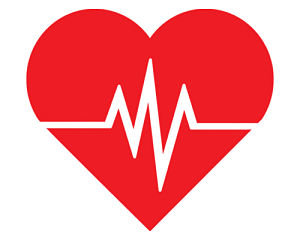
A red heart with an EKG line through the middle
How's Your Heart?
Do a Heart Checkup during the month of FebruaryHeart disease is the leading cause of death for men and women in the United States. Every year, 1 in 4 deaths are caused by heart disease. Unfortunately, Heart disease doesn't happen just to older adults. Heart disease-and the conditions that lead to it-can happen at any age. It is happening to younger adults more and more often. On average, U.S. adults have hearts that are 7 years older than they should be https://www.cdc.gov/vitalsigns/heartage/. February is Heart Month, the perfect time to learn about the risks for heart disease and the steps needed to take now to help your heart. Are You at Risk?
Many of the conditions and behaviors that put people at risk for heart disease are:
• High blood pressure. Millions of Americans of all ages have high blood pressure, including millions of people in their 40s and 50s. About half of people with high blood pressure don't have it under control. Having uncontrolled high blood pressure is one of the biggest risks for heart disease and other harmful conditions, such as stroke.
• High blood cholesterol. High cholesterol can increase the risk for heart disease. Having diabetes and obesity, smoking, eating unhealthy foods, and not getting enough physical activity can all contribute to unhealthy cholesterol levels.
• Smoking. More than 37 million U.S. adults are current smokers, and thousands of young people start smoking each day. Smoking damages the blood vessels and can cause heart disease.
Some of the other conditions and behaviors that can affect your heart are:
• Obesity. Carrying extra weight puts stress on the heart. More than 1 in 3 Americans-and nearly 1 in 6 children ages 2 to 19-are obese.
• Diabetes. Diabetes causes sugar to build up in the blood. This can damage blood vessels and nerves that help control the heart muscle. Nearly 1 in 10 people in the United States have diabetes.
• Physical inactivity. Staying physically active helps keep the heart and blood vessels healthy. Only 1 in 5 adults meets the physical activity guidelines of getting 150 minutes a week of moderate-intensity activity.
• Unhealthy eating patterns. Most Americans, including children, eat too much sodium (salt), which increases blood pressure. Replacing foods high in sodium with fresh fruits and vegetables can help lower blood pressure. Only 1 in 10 adults are getting enough fruits and vegetables each day. Diets high in sugar and fat increase the risk factor for heart disease.
4 Ways to Take Control of Your Heart Health
You're in the driver's seat when it comes to your heart.
Don't smoke. Smoking is the leading cause of preventable death in the United States. If you don't smoke, don't start. If you do smoke, learn how to quit.
Manage conditions. Work with your physician to manage conditions such as high blood pressure and high cholesterol. Make sure you take any medication prescribed for these conditions.
Make heart-healthy eating changes. Eat foods low in trans-fat, saturated fat, added sugar and sodium. Try to fill at least half your plate with vegetables and fruits, and aim for low sodium options.
Stay active. Get moving for at least 150 minutes per week. You can even break up the 30 minutes into 10-minute blocks if that is helpful.
If you think you have any indications of the above risk factors for heart disease, make an appointment with your primary care provider or call to make an appointment with one of the Sabetha Family Practice providers at (785) 284-2141. If you have questions regarding heart health, contact the Sabetha Community Hospital Cardiac Rehab Department at (785) 284-1501.
